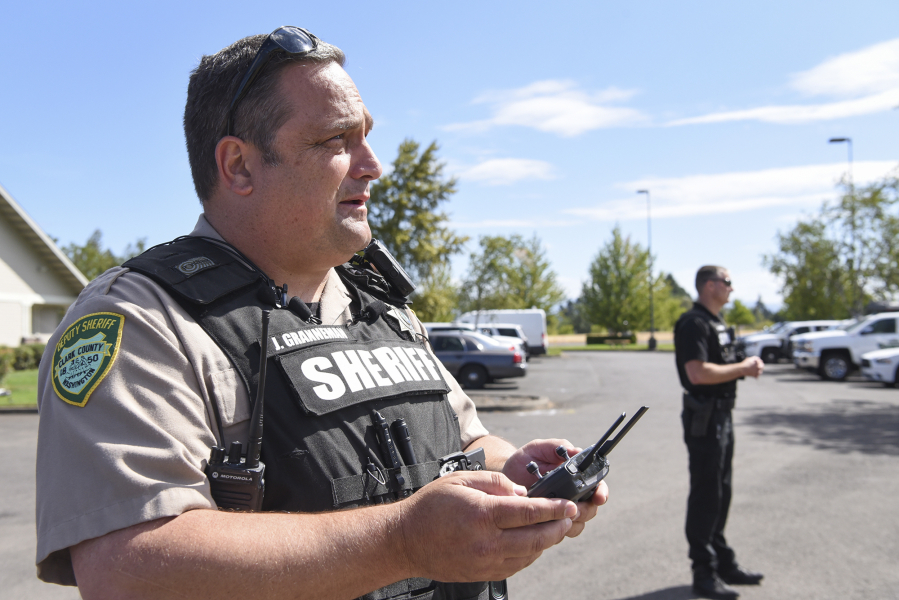A hostage situation. A search-and-rescue mission. Someone trapped under rubble. These are all scenarios the Clark County Sheriff’s Office might now be assisted by an “eye in the sky.”
The sheriff’s office unveiled Thursday five new quadcopters it plans to use as law enforcement tools, making Clark County the second sheriff’s office in Washington state, other than Cowlitz, to use such technology.
“The community will be safer,” said Deputy Jason Granneman, one of the five certified pilots of the unmanned aircraft systems, or UAS.
The machines are sometimes referred to as drones, but Granneman is quick to point out that they are not like the military-grade drones used in warfare or spying.
“We’re not just flying these around every day doing mass surveillance,” he said. “They are very, very inexpensive helicopters.”
Granneman came up with the idea over 18 months ago, and then undertook the lengthy permitting process through the Federal Aviation Administration.
The flight
Granneman flew the drone Thursday at the county’s Public Safety Complex in a public demonstration of the unmanned aircraft initiative.
He unzipped a small backpack and pulled out the $1,500 drone, about the size of a book. “They can fit into a cargo pocket,” he said. Granneman unfolded the four legs. “Most people are amazed when you pull (the aircraft) out,” he said. He popped in the battery and uncapped the 4K camera on swivel stabilizers.
The small drones are a good entry-level device, Granneman said, but he hopes to grow the program to have larger quadcopters that carry infrared cameras and may drop first aid kits or water to people during rescue situations.
Granneman stood back from the aircraft, controlling it with a joystick remote that has an attached iPhone showing a live video feed from the aircraft to help the pilot navigate. The blades of the drone hum and spin; the device lifts off into a precise hover.
The FAA considers the quadcopters to be aircraft, so each flight must undergo a permitting process that takes between one and four hours.
The sheriff’s office must confirm with the FAA that the flight is safe, but under specific emergency scenarios pilots may launch them immediately, Granneman said. The time from unpacking to launch takes less than 5 minutes.
Granneman targeted a port-a-potty in an open field and flew the drone in circles around it, 60 feet in the air. He could see, through the iPhone screen, a birds-eye view of the structure. He touched the screen, and it logged the longitude and latitude that could be used for search-and-rescue missions.
Granneman said the battery life lasts about 26 minutes without high wind. But the craft also can’t fly in winds over 33 mph.
The FAA trained the five pilots for more than 80 hours online. “It was very challenging,” Granneman said.
The machines use a collision avoidance system, so the risk for crash is almost none, Granneman said, and they hover high enough to where they are out of range from objects or even net guns. Each quadcopter is fully insured.
When the battery runs out, the quadcopter will automatically track back to the place where it launched, but Granneman summoned the aircraft back with a button.
It touched down, and the blades stopped. “Safe!” he said.
Join the list
Clark County joins a growing list of cities and counties around the country that use drones to aid law enforcement and search-and-rescue missions.
The Seattle Police Department tried to implement drones, but shut down those efforts after public disapproval and concerns of government spying and invasion of privacy.
In Pullman, three police officers recently went through training and are permitted to use drones, but officials there are still developing policies before the officers start carrying them in their vehicles.
Cowlitz is the only other Washington county to use them, stretching back to 2016. Sheriff’s deputies used one in the search of a body in wooded areas along the Coweeman River, as reported in The Daily News in Longview. The drones helped officials survey the area and take aerial photographs for the case.




